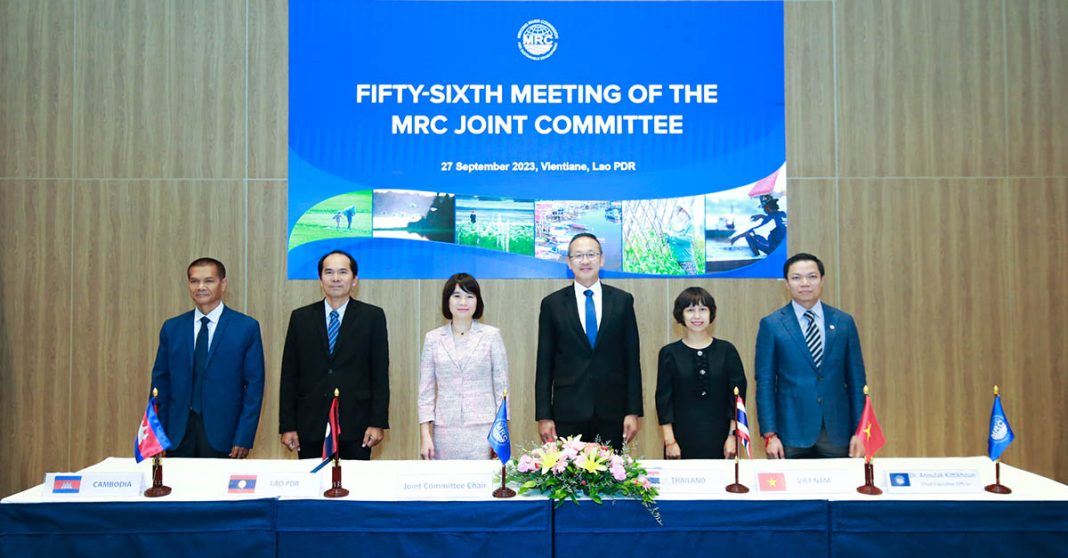The governing body of the Mekong River Commission took a significant step this week towards creating a “Mekong Fund” for Southeast Asia’s largest waterway that will provide direct and indirect assistance to the residents hit hardest by the adverse impacts of climate change-driven drought and flooding, combined with water infrastructure development.
At its 56th gathering, held on 27 September in Vientiane Capital, the MRC Joint Committee (JC) approved in principle the funding model and trial run for the Mekong Fund, which will launch in 2025, endorsing its core design, funding mechanism, governance structure, and likely beneficiaries. The trial run will focus on the so-called Ecosystem Window of the Mekong Fund, creating grant-giving opportunities for projects that strengthen livelihoods and safeguard the environment.
The MRC Secretariat is partnering with Germany to finance this Ecosystem Window, through its Federal Ministry of Economic Cooperation and Development and the KfW Development Bank. This trial run is expected to evolve into permanent innovative financing for the MRC, within five years.
“We must not only mitigate the impact of development and climate change but support those communities suffering the most from changes to the river’s flow regime and across the Lower Mekong Basin,” said the 2023 Chairperson of the MRC Joint Committee, Mrs. Nguyen Thi Thu Linh, who is also Director General of the Viet Nam National Mekong Committee.
Through the 1995 Mekong Agreement, the MRC was primarily founded to balance the trade-off between the economic benefits of development and minimizing any impact on the river’s ecosystem and the millions of fishing and farming families relying on it. Climate change-caused flood and drought has since exacerbated the situation. In addition to pushing for mitigation policies, procedures, and projects, the MRC aims to introduce a compensatory component through the Mekong Fund.
The trial run of the Ecosystem Window will specifically “disburse funds to support and facilitate local community engagement in wetland and watershed biodiversity conservation and related livelihood improvement in and around regionally significant ecosystems.” The next phase of the process will be a Feasibility Study on how exactly to establish this Ecosystem Window.
In other matters covered at their 56th meeting, the JC heard progress reports on an array of topics: the Sanakham and Phou Ngoy Hydropower Projects consultation processes; the cooperation mechanisms for data-sharing on how existing dams are operating; communication mechanisms for water-related emergencies; finalizing the Riverine Plastic Monitoring Protocols (RPM); and how the RPM might be integrated within the recently redesigned Core River Monitoring Network.
MRC, China, and Myanmar step up joint activities
Within the MRC’s cooperation framework, the MRC and Dialogue Partners China and Myanmar yesterday agreed to start up new initiatives to collect, monitor, and share the near real-time information on storage levels and hydropower operations that are vital to flood and drought management.
Laos and Myanmar will conduct joint discharge and sediment monitoring in the Xieng Kok station, which sits on Laos’ northern border with Myanmar. Unveiled last year, the Xieng Kok station is the first water level monitoring station positioned atop the LMB. The joint monitoring will provide the MRC with the river flow and sediment information from along this section of the river, which is currently absent from the MRC’s coverage.
In addition, Thailand and Myanmar will explore a joint monitoring service and early flood warning system in the Nam Mae Sai-Nam Ruak River, a tributary of the Mekong along the borders of the two countries. The MRC and China will also work to prepare an annual joint report on the hydrometeorological and environmental conditions of the Lancang-Mekong River, as well as notifications of urgent data and information related to flood, drought, and water related emergencies. This latter initiative will especially help the local riverine communities prepare for the risks and uncertainties resulting from the changing flow and river conditions.
At this 27th meeting, the MRC and Dialogue Partners also reviewed cooperation progress and explored further areas to work together. The discussion at the 27th meeting was built on the historic joint meeting, held in mid-September in Beijing, between the MRC JC and Lancang-Mekong Cooperation Joint Working Group on Water Resources Cooperation.
The MRC began working with China and Myanmar in 1996 when the two countries agreed to become Dialogue Partners.



